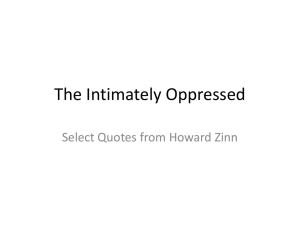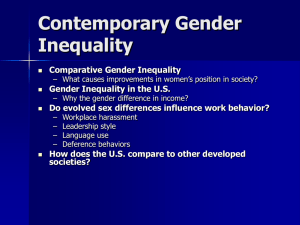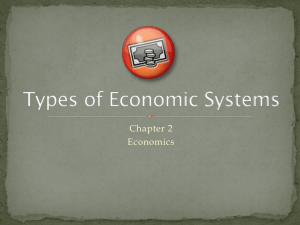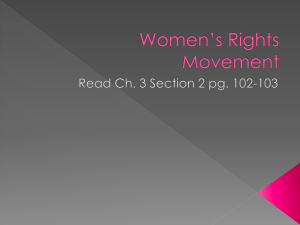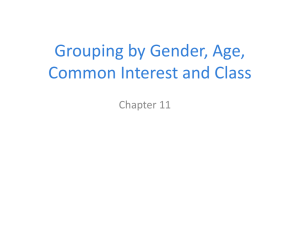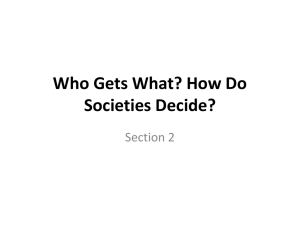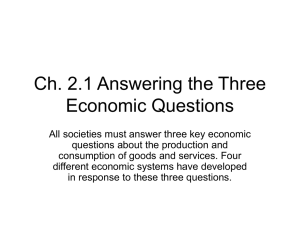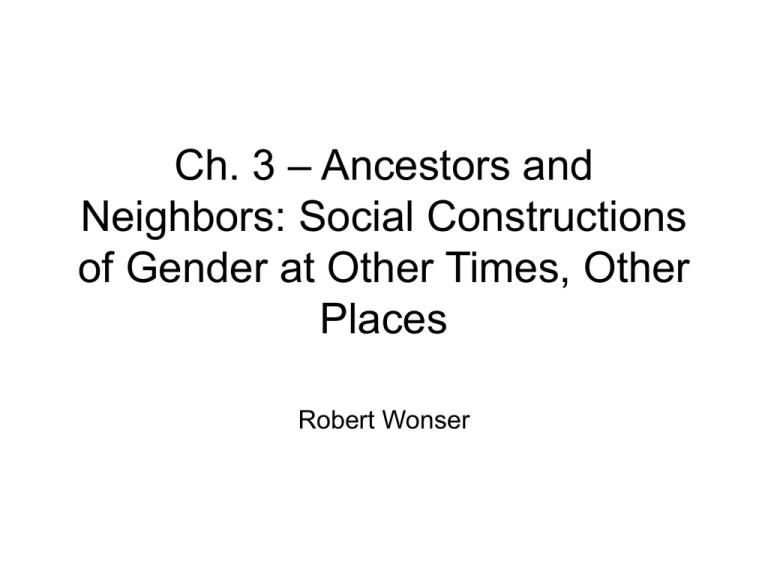
Ch. 3 – Ancestors and
Neighbors: Social Constructions
of Gender at Other Times, Other
Places
Robert Wonser
Man the Hunter Theory
• The club-wielding caveman of pop culture lore may not
be accurate.
• We examine:
• 1) the archeological record; which includes fossil
remains
• 2) primatology, especially studies of living nonhuman
primates, such as chimpanzees and bonobos; and
• 3) anthropological studies of preindustrial societies which
scientists believe may be very similar to, if not replicas
of, the earliest human communities
Bones and Stones: The
Archeological Record
• This is a difficult task, we have little fossil record
to go on
• More importantly, “behavior leaves no fossils”
• The further back we go, the less fossil record we
have
• Consequently, “the fossil record available for
study is not a representative sample of the
human groups that have inhabited the earth.”
Man the Hunter Myth
•
•
•
•
•
•
The account goes like this:
Sometime between12-28 million years ago, our ancestors were forced from the trees
as the climate became dryer. We adapted to the ground: bipedalism – we began
walking on two feet change in our physical structure; the pelvis had to narrow to
hold in our guts our brains grew bigger compared to our relative body size
offspring were born sooner because they couldn’t remain inside of mothers because
of the pelvis issue. Therefore, when children are born they require more time spent
with their mothers mothers rear and men go out and hunt since foraging didn’t
suffice.
Hunts were more successful when men banded together led to better
communication (language) and tools (weapons for hunting).
We see the birth of the sexual division of labor—women as caretakers of the home
and children and men as breadwinners and protectors—was adaptive; those who
conformed to it enjoyed a distinctive advantage for survival.
Mutually exclusive roles gave rise to male and female personality traits—women grew
to be empathetic, nurturing and dependent, men grew to be daring, unemotional, and
aggressive.
Over time these adaptive characteristics were also naturally selected for in the
evolutionary process.
So, what’s the problem with the
Man the Hunter myth?
• Did you notice that this myth conveniently bears an
uncanny resemblance to the traditional, middle-class
nuclear family of Western societies?
• Who was/is anthropology dominated by?
• As we know, the values and beliefs of our society, as
well as those of specific groups we belong to
(anthropologists for instance) can influence or bias our
understanding of the world around us.
• Feminists highlight two major criticisms:
• Ethnocentrism and androcentrism
Ethnocentrism and Androcentrism
•
•
•
•
•
•
•
•
•
•
ethnocentrism means that one views one’s own cultural beliefs and practices as
superior to all others.
Man the Hunter is ethnocentric in 2 ways:
1) it inaccurately depicts contemporary Western gender relations as universal, both
historically and cross culturally
2) the argument implies that the contemporary Western model of gender relations is the
only correct or appropriate model because it is natural and adaptive.
Androcentric means male-centered. The theory clearly emphasizes male behavior, with
females being overlooked or at best, portrayed as passive child bearers.
Alternative explanations exist; equally plausible as androcentric versions. For instance,
early technology could have been slings for carrying babies while allowing for gathering
of food.
Gender attribution is the process of linking archeological data (e.g. tools and other
artifacts) with males and females.
Rests on assumptions about what males and females did in prehistory, but these
assumptions have often been colored by contemporary stereotypes of appropriate
masculine and feminine behavior.
Careful not to engage in gynecentrism (that is, “woman-centeredness”) in
reconstructing history from a feminist perspective
What does the interpretation of, rather than even the actual, Venus statue in your text tell
us about gender norms today?
Our Primate Relatives
•
•
•
•
•
•
•
•
•
•
Our archeological record is full of gaps
Primatology – research on living, nonhuman primates. we’re very close to chimpanzees
and bonobos (we differentiated about 6 million years ago; a blink of the eye evolutionarily).
Can you anticipate some o the problems with this line of research?
Who does the research? Are they without bias?
There is tremendous variation amongst primates today
– 200 species of primates 40% females are equal to or dominant over males.
– Therefore it is possible to cite any particular species for evidence of the particular trait
you’re looking for.
Finally, apes evolutionary past contributes to their present day traits; meaning we’ve evolved
as have present day monkeys and apes.
Notice the similarity to Man the Hunter?
Primate herds were said to be organized into dominance hierarchies and competed fiercely
for resource.
Why did these stereotypes emerge? Based on limited observations of only certain apes.
Most primate groups are matrifocal, group life and social organization center around
mothers.
–
•
E.g. even though male chimps may try to intimidate females into mating with them; it is the female who
typically initiates sexual activity with several males who must wait their turn.
Chimps and humans are omnivorous that is, they eat vegetables and meat. Both males and
females acquire food; females usually provide for their offspring; when it is shared, it is
governed by age, genealogical relationship, and friendship.
So, apes and us
• What does all this tell us?
• Limited due to the problems of generalizing our behavior
and past from contemporary primates as well as
numerous primates (with different behavioral patterns).
• At the very least, such research calls into question
stereotypes derived from early cursory reviews of small
percentage of primate species and highlights the
important roles females play in structuring primate
societies.
• Many primates live in groups characterized by sociability
and cooperation among males and females; which, are
also not unknown among contemporary human
societies.
Women and Men Elsewhere
•
•
•
•
•
Are Western constructions of gender universal?
What did Margaret Mead’s findings show us? She studied 3 tribes in New
Guinea.
She observed cultures in which men were expected to be timid and
nurturing and women were expected to be aggressive and competitive
Every society does have a division of labor based on gender (and age).
However, what is considered men’s work and women's work varies from
culture to culture.
– E.G. in some cultures, women build the houses, in most, do the cooking (but
some exceptions).
•
•
•
Very few societies where women participate in metalworking, lumbering and
hunting large land and sea animals although there are some exceptions.
Most agree that men hold a monopoly on the use of physical violence in all
societies.
Considerable evidence that women may behave as aggressively as men,
particularly when competitiveness and verbal abusiveness are included as
measures of aggression.
Gender Relations in Contemporary
Foraging Societies
• Most like our primitive past (not exactly though)
• The foraging society is also referred to as the hunting-gathering
society because its members meet their survival needs by hunting
game (and fishing) and by gathering vegetation and other types of
food in their surrounding environment.
• Even though it is usually thought that men hunt and women gather;
there is in fact consider overlap.
• Six variations:
–
–
–
–
–
–
1. men hunt, women process the catch;
2. men hunt, women gather;
3. men hunt, men and women gather;
4. men hunt and fish, women hunt and gather;
5. men and women independently hunt, fish, and gather’
6. men and women communally hunt and gather.
1. Men hunt, women process the
catch
• Ex: the Eskimo
• Meat and fish are dietary staples and men are the chief food
providers.
• This puts women at a disadvantage relative to me; they are
dependent on men for food as well as for goods obtained through
trade with non-Eskimos. men have more power and prestige than
women.
• Women are not powerless though, nor is women’s work considered
unimportant.
• Women gather as well as make clothes. Think about how important
warm clothes are where the Eskimos live!
• “.. The question, ‘Which is better (or more important), a good hunter
or a good seamstress?’ is meaningless in Eskimo; both are
indispensable”
• Despite all this; this type is the least egalitarian of the foraging
societies.
The other Five types
• Women in these societies take a much more active role in food
acquisition more equal access to societies’ resources and
rewards.
• Ex: the Ju/hoansi have a clear division of labor by sex but it is not
rigidly conformed to with men and women sometimes doing each
others’ chores.
• Childrearing is viewed as the responsibility of both parents. As
children grow up there are few experiences that set one sex apart
from the other.
• Childrearing- nonauthoritarian; like their society in general
• Aggressive behavior on the part of men is discouraged and they
rarely engage in organized armed conflict.
• Although boys are taught from a young age how to kill large animals,
they are not taught to kill other people.
• Egalitarian gender relations like the Ju/hoansi are characteristic of
the other types of hunting and gathering societies on our list.
Other types (continued)
•
•
•
•
•
One sex is not intrinsically valued over another.
Respect is earned based on his or her contribution to the general well-being of
the group.
– E.G. the Aka (type six) who live in the rain forests of Central African
Republic
– Work is a collective enterprise and few tasks are exclusively assigned to
one sex
– Women, men and children care for infants, forage together for nuts,
vegetation, and caterpillars; and hunt cooperatively.
– Aka fathers are more likely to kiss, hug or soothe a fussy infant that they
are holding. Aka fathers hold their infants 5 times more than any other
father in other cultures.
– Cooperative interdependence is associated with highly egalitarian gender
roles.
Not limited to foraging societies:
The Vanatinai (island off of mainland Papua New Guinea) are horticultural and
their division of labor and gender relations are egalitarian.
In short, Vanatinai society “offers every adult, regardless of sex or kin group ,
the opportunity of excelling at prestigious activities such as participation in
traditional exchange or ritual functions essential to health and prosperity”
Cross Cultural Data indicates:
• 1) contemporary Western constructions of
gender are not universal.
– Much variation of gender relations cross-culturally
and some are highly egalitarian
– Contemporary hunting and gathering societies (if
representative of past cultures) do not support Man
the Hunter theory but instead reinforce archeological
and primatological data that indicate that at least
some of our ancestors lived in groups characterized
by cooperation and reciprocity and in which adults
(male and female) actively contributed to group
survival.
Cross cultural data indicates
• 2) the gendered division of labor does not
necessarily produce gender inequality
– Key intervening variable: the value placed on a
particular role or task.
– Our society: women’s work is less valued; in other
societies women are seen as “essential partners” in
the economy and decision making even though they
may be responsible for different tasks.
– “many nonclass societies have no problem seeing
differentiation without having to translate it into
differential worth.”
Cross cultural data indicates:
• 3) women’s capacity to bear children does not
automatically exclude them from certain activities
because they bear children; nor are men automatically
excluded from childrearing because they cannot bear
children
– In preindustrial societies, childbearing and childrearing does not
isolate mothers the way they do in our society.
– The tasks are absorbed into a broader range of people, and
children are more incorporated into public activities. Moreover,
motherhood conveys an increase in status, giving women
greater say in matters.
– Nonbiological factors—environmental resources, size of the
group, the economy, and ideology—play a more significant part
in determining what is defined as appropriate “men’s work” and
“women’s work” than do biological factors.
Multiple Genders
•
•
•
•
•
•
•
•
•
Gender is not a dichotomous category.
Some societies have three genders, some four.
The berdache of some Asian, South pacific, and North American Indian societies.
Berdaches are individuals who adopt the gender behavior ascribed to members of the
opposite sex. Women can become berdaches but most research focuses on men.
Berdaches lived, worked, and dressed as members of the opposite sex, although
they were often specialists in tasks associated with both sexes.
The Mohave, for instance allowed men and women to cross genders. Boys who
showed a preference for feminine toys and clothing would undergo an initiation
ceremony at puberty during which they became alyha. As alyha, they adopted
feminine names, painted their faces as women did, performed female tasks, and
married en. When they married, alyha pretended to menstruate by cutting their upper
thighs.
A Mohave female who wished to pursue a masculine lifestyle underwent an initiation
ceremony to become a hwame.
Hwame dressed and lived much like men; engaged in hunting, farming, and
shamanism (although they weren’t allowed to assume leadership positions or
participate in warfare).
Important to note: neither hwame nor alyha were considered abnormal or deviant
within their cultures.
More about Berdaches
•
•
•
•
•
•
•
•
Extensive research conducted on Zuni berdaches, called lhamana by this
American Indian nation.
Although they cross-dressed, they are not transvestites or transsexuals
because their cross-dressing was routine, public, and without erotic
motives.
Nor were berdaches necessarily homosexual as we think of sexual
orientation.
There were Zunis who were sexually oriented to the opposite sex, some to
the same sex, and still others who were sexually attracted to berdaches.
Berdaches were not viewed negatively or as deviants because the Zuni’s
conception of gender acquisition, which maintains that gender is not born
with but develops over one’s lifetime.
Until age six, children aren't called “boy” or “girl” but simply “child”
Berdaches were not seen as a threat to a rigid gender ideology but as an
affirmation of humanity’s original, pre-gendered unity—representatives of a
form of solidarity and wholeness that transcended the division of humans
into men and women.
Assimilation into White society has caused many berdaches shame and to
hide this status.
Other genders
• Examples of gender crossing include Tahitian culture; among the
Omani Muslims; and the Hijras of India.
• Gender as a process rather than fixed category.
• Among the Hua of Papua New Guinea, gender is perceived as
changing throughout one's life.
• Masculine- high status but weak and vulnerable
• Feminine- invulnerable but polluted.
• Children are at least partially feminine because mothers pass it onto
their offspring.
• more children a mother has the less feminine she becomes.
• after 3 births she is no longer considered polluted.
• She can participate in discussions and rituals with men and share their
status and authority but must also observe their diet and sanitation
because she is now vulnerable.
• For men, they lose their masculinity gradually by imparting it to boys
during growth rituals consequentially becoming more polluted.
• Gender is fluid
Gender, Evolution and Culture
• At first we only had the Man the Hunter theory.
• Then we overcorrected and went to a gynecentric view.
• In reality, and as the evidence suggests, at least some
human communities were probably cooperative and quite
flexible in their social organization.
• Women weren’t passive dependents on men but were
active participants and providers
• How did we get from there to where we are now, a society
characterized by gender inequality?
• Population growth, increased environmental danger from
ecological changes and warfare, the establishment of trade
and exchange relations between societies, change from
nomadic to sedentary lifestyle and technological advances
facilitating surpluses probably all played a role.

